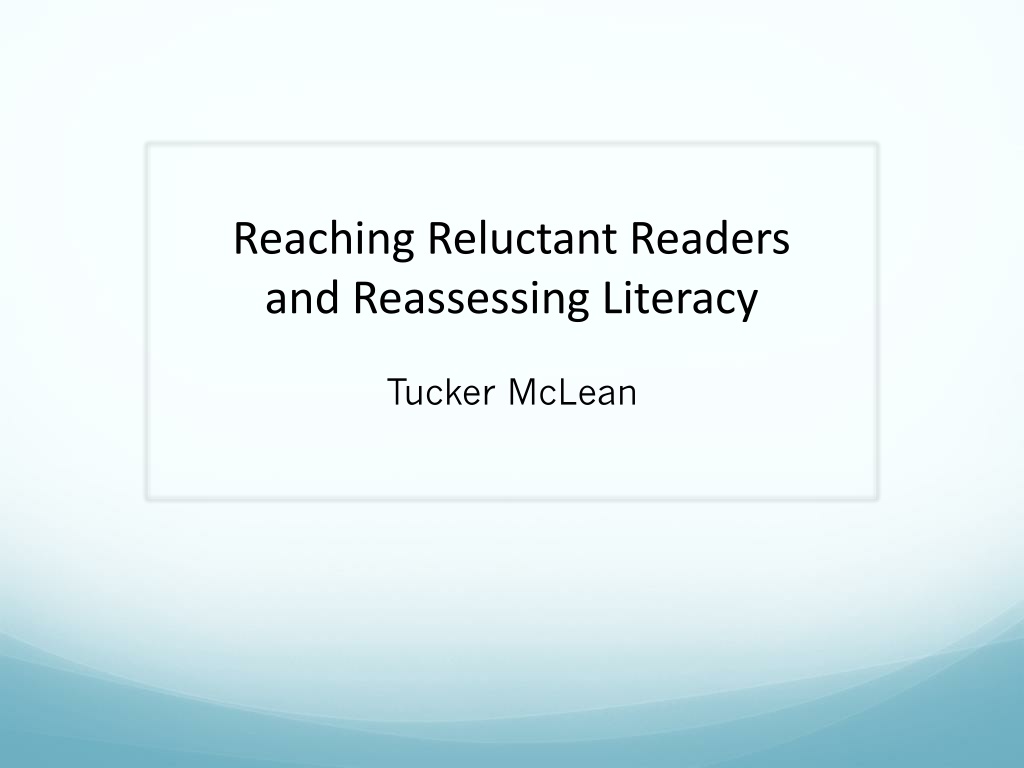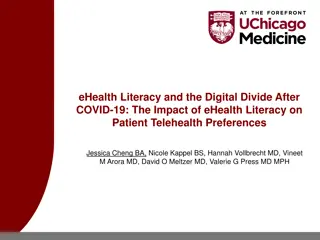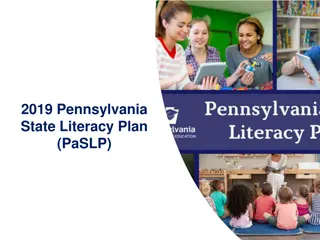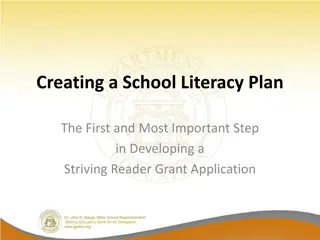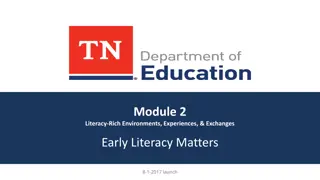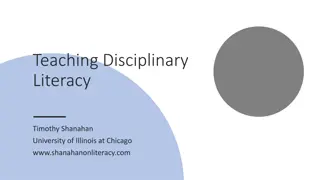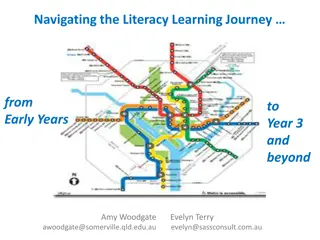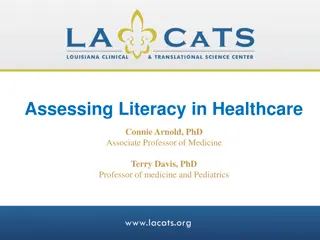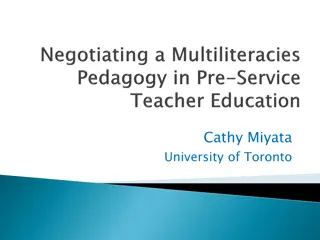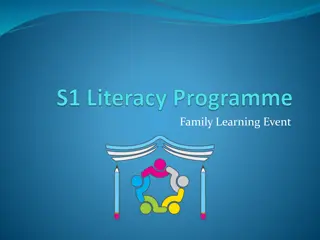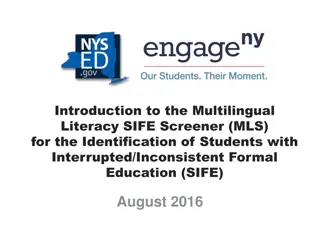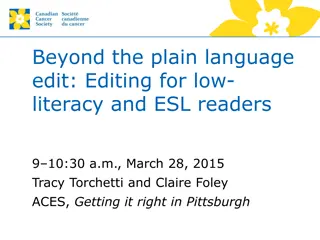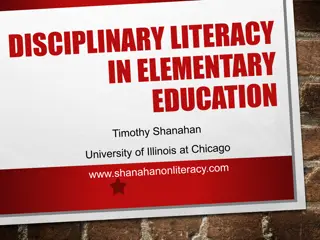Understanding and Supporting Reluctant Readers in Literacy Education
Reluctant readers are a diverse group with various reasons for their reluctance. Strategies to engage and support struggling readers include creating a safe and supportive environment, interrupting negative thinking cycles with small successes, and providing high-interest, low-vocabulary nonfiction books. Teachers must understand the underlying issues to effectively assist reluctant readers in developing their literacy skills.
Download Presentation

Please find below an Image/Link to download the presentation.
The content on the website is provided AS IS for your information and personal use only. It may not be sold, licensed, or shared on other websites without obtaining consent from the author. Download presentation by click this link. If you encounter any issues during the download, it is possible that the publisher has removed the file from their server.
E N D
Presentation Transcript
Reaching Reluctant Readers and Reassessing Literacy Tucker McLean
Questions to Consider Who are reluctant readers, and why are they reluctant? What can we do as teachers to encourage and motivate reluctant readers?
Who are reluctant readers? Reluctant readers are a diverse group (Stringer 71) If we can t place why a reader is reluctant it becomes increasingly difficult to try and engage them. We have to discern why they are reluctant in order to help them. (Hebb 22)
Why are these readers reluctant?
1. Readers Struggling with Literacy These are readers struggling with the foundational mechanics of reading and literacy itself These students often show signs of a limited vocabulary and minimal comprehension skills Often feel frustrated, confused and inadequate when it comes to reading Some may feign disinterest or lack of motivation to hide embarrassment or shame at their difficulties with literacy
1. Readers Struggling with Literacy (Continued) English Language Learners Difficulty in learning English means they could become self conscious in reading English literature They may be more inclined to read literature in their native language
What can we do to assist struggling readers? All readers need an environment that is safe, supportive, and encouraging, yet challenging (Hebb 22). We must interrupt cycles of negative thinking with carefully constructed successes (Frey and Fisher 9) Scaffolding helps teens attempt relatively difficult reading they couldn t and wouldn t attempt on their own (Stringer 72) High interest/low-vocabulary nonfiction books can provide students with valuable, content-embedded information at a comfortable, comprehensible reading level, thereby allowing learning to advance while reading skills are developed. (Frey and Fisher 14)
What can we do to assist struggling readers? (Continued) Using cross-cultural themes, ELLs can connect with a genre to allow for comparison and contrast Try promoting a home/school connection where reading is done at home Reading aloud can provide an example of good oral language, allowing students to gain experience in group listening and allow them to expand their vocabulary (Frey and Fisher 15)
Methods for Bettering Comprehension Alternative Mediums to bridge gaps between texts: Graphic Novels Audiobooks EBooks Alternative Genres: Folktales/Mythology Song Nonfiction Offering Activities that Appeal to Different Learning Styles Book Circles Role-play Reading Aloud
2. Unmotivated Readers Statistically speaking, reading interest and motivation peaks in grade 1, anddeclines after that (Mckenna quoted in Frey and Fisher 7) What are some potential reasons readers are unmotivated?
Reasons Students may be Unmotivated (Hebb 22) Self-conscious/fear of failure Unchallenged Bored Emotional disturbances Family disruption/lack of exemplary role models Peer pressure Cultural background might discourage it Students could have previously been given the impression that they are poor readers, so they internalize it as fact, known as learned helplessness (Stringer 73)
2. Unmotivated Readers (Continued) The Adolescent Boy According to the 2006 handbook Connecting with Reluctant Teen Readers: 43% of adolescent boys don t read, or only read what they have to 57% of adolescent boys enjoyreading Aliteracy The state of being able to read but being uninterested in doing so (Larry Mikulecky) It isn t an issue that boys won t read, only that we aren t engaging them with the readings we re providing (Jones, Hartman and Taylor quoted in Jeffery 2009)
How might we help readers who are uninspired, uninterested and unmotivated? Talk amongst your tables for a few moments
The Traditional Divide between School Reading and Pleasure Reading School Reading Pleasure Reading
Reconciling School and Pleasure Reading Both classic and traditional literatures often address controversial ideas and topics, but, because classic texts have an accepted place in literary history, the material is often considered educational and safe for students. Writers of YA literature regularly explore the reality of being a teenager today, and issues of sexuality, violence, drugs, and depression frequently emerge. Without the weight of history behind them, YA titles and their authors more readily come under attack. 10) (Glenn et. Al
Reconciling School and Pleasure Reading (Continued) In the exploration of the given theme, the YA text plays a central role in supporting reading, writing, thinking, and speaking skills among students, all while creating opportunities for students to deepen and enrich their understanding of big ideas, themselves, and others. (Glenn et. Al 11)
Reconciling School and Pleasure Reading (Continued) Building a bridge between the classics and more contemporary titles in the context of a thematic unit allows for richer discussion Try and consider designing the literature curriculum thematically from questions of high interest for adolescents and infusing this study with YA titles that offer contemporary takes on age-old problems and encourages a deeper understanding of literature and the larger world. (Glenn et. Al 12)
How do we judge the educational value of literature? Talk amongst your tables for a few moments
Pick Texts That Interest Them By letting students have a say in what they read we show respect for their choices If a student shows some semblance of self-efficacy, allow them some autonomy. Make every reading experience one they can learn from This independence as an effect counters any learned helplessness This isn t to say we shouldn t direct or guide their reading, only that we should try and find the merit in any of the reading students engage in By drawing out the themes and elements in what students are reading we could enable them to become cognizant of the reading they consume everyday Try the I ll read yours, if you read mine mentality
Let Them Read Trash: The Power of Marginalized Texts to Promote Imagination, Satisfaction and Social Action Jeffery D. Wilhelm Horror Shock/Dark Fiction Romance Series Books Dystopia Mystery Fantasy Historical Fiction Science Fiction Manga/Graphic Novel
Teaching Trash Activity In groups of three you will be appointed what is traditionally considered a lowbrow literary genre that is popular amongst adolescents to contemplate how you would teach that genre to students Try and consider the educational merit in these potentially problematic texts How might you teach a text in this genre? What are the accompanying challenges? What opportunities might this reading create?
Reaching Reluctant Readers through Multiliteracies Against this changing communicational landscape, which can be typified by diversity and plurality, the dominant view of literacy as a universal, autonomous, and monolithic entity is at best dated and in need of reconsideration (Jewitt 244) Mulitieracy sets out to stretch literacy beyond the constraints of official standard forms of written and spoken language to connect with the culturally and linguistically diverse landscapes and the multimodal texts that are mobilized and circulate across these landscapes. (Jewitt 245) The classroom construction of literacy occurs through the legitimation and valuing of different kinds of texts and interactions (Jewitt 248)
Visual Texts Reimagining Literacy
The Graphic Novel How do images create meaning? How and why are techniques are used? Film For the reluctant learners, film is a way to demystify the sometimes esoteric world of the metaphoric where most literature resides (Smilanich 605) Video Games Interactive Storytelling
Electronic Texts Teachers are wise to tap into the tools used by teens voluntarily (Adams 58)
What do new technologies allow us to do in a classroom setting? These forms of media allow us to be consumers and creators of content Many digital mediums allows us to write and publish something instantaneously We can work collectively and collaboratively The Classroom can extend outside of school
Reading for Different Purposes In order to gain experience, students need opportunities for frequent reading, both focused, guided reading and free reading (Hebb 22) Reading and writing are connected, mutually reinforcing processes. Rather than ends in themselves, they are a single act of literacy, with shared cognitive processes that should be taught together for the purpose of extending thinking, expanding learning, and transforming knowledge. (Hebb 22)
Twitter David Mitchel Serialized Storytelling Collaborative Stories Teju Cole Flash Fiction For sale: baby shoes, never worn Attributed to Ernest Hemingway An Englishman enlists in the Foreign Legion: to avoid spending Christmas with his mother-in-law. Author Teju Cole I am happy the leaves are growing large so quickly. Soon they will hide the neighbor and her screaming child Author Lydia Davis
How should we evaluate new media/technology when developing methods of teaching? Talk amongst your tables for a few minutes
Challenges to Using Technology in the Classroom Our use needs to be directed and focused We need to ensure students learn ethics and etiquette with new technology We have to plan the lesson in consideration of our objectives, then see if there are applications where technology can augment the subject matter
In Closing Readers are often reluctant for varying reasons, be it disinterest or difficulty with language itself, and they all have different incentives that might motivate them to become engaged. In considering multimodalities in our teaching we can offer students lesson variety and opportunities to improve their proficiency within a pluralized concept of literacy. When trying to engage reluctant readers: Focus on Content not Form Focus on Process not Product (Hebb 23)
References Adams, M. G. (2009). Engaging 21st-century adolescents: Video games in the reading classroom. The English Journal, 98(6), 56-59. Frey, N., & Fisher, D. (2005, January 1). You Got More of These? Re-engaging Adolescent and Writers with Meaningful Texts. Random House Inc., 7-12. Readers Glenn, W. J., King, D., Heintz, K., Klapatch, J., & Berg, E. (2009). Finding space and place for young adult literature: Lessons from four first-year teachers engaging in out-of-school professional induction. ALAN Review, 36(2), 6. Hebb, J. L., & Axiotis, V. (2000). Reluctant readers reading. English Journal, 89(4), 22. James, K., Dobson, T. M., & Leggo, C. D. (2013). English in middle and secondary classrooms: Creative and critical advice from canada's teacher educators. Toronto: Pearson Canada. Maynard, S., & Earl, A. (2006). WHAT MAKES A CHILD A RELUCTANT READER? New Review of Children's Literature and Librarianship, 12(2), 163-181. doi:10.1080/13614540600982959 Rowsell, J., & Walsh, M. (2011). Rethinking literacy education in new times: Multimodality, multiliteracies, & new literacies. Brock Education, 21(1), 1. Smilanich, B., & Lafreniere, N. (2010). Reel teaching = real learning: Motivating reluctant through film studies. Journal of Adolescent & Adult Literacy, 53(7), 604-606. students Stringer, S. A., & Mollineaux, B. (2003). Removing the word "reluctant" from "reluctant reader". English Journal [H.W.Wilson - EDUC], 92(4), 71. Woolfolk, A.Human development, learning, and diversity (EPSE 308 2014-2015)
Lesson Planning Resources The Guardian Teen Book Recommendations: http://www.theguardian.com/books/teen-books Picture Book Use in Secondary Classrooms: http://ccb.lis.illinois.edu/Projects/childrenslit/lrich ter/403FinalProjectDoc.html
Further Discussion Questions How do we develop a modern curriculum to cater to students interests as well as higher literary ideals? How do we balance our lessons between traditional and nontraditional texts? What might be the advantages and drawbacks to developing our teaching around an inquiry based model?
